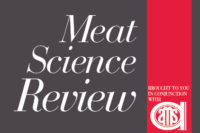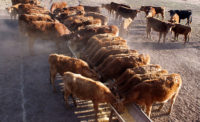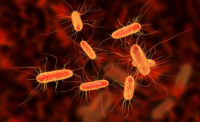Meat Science Review: Bacterial immobilization on cattle hides
A novel concept for reducing bacterial contamination of beef carcasses.

 The meat of healthy cattle is sterile and surrounded by two areas that are highly contaminated with microorganisms. These areas are the hide and the intestinal tract.
The meat of healthy cattle is sterile and surrounded by two areas that are highly contaminated with microorganisms. These areas are the hide and the intestinal tract.
Because cattle hides can carry pathogens, there is a crucial need for technologies to prevent or minimize microbial cross-contamination from these sources. Two potential approaches to decontamination technology are: (1) decontamination of the hide before dressing or (2) decontamination of the carcass after de-hiding. Most decontamination techniques focus on physical removal or killing of microorganisms on the hide, using heat (80 ºC maximum) or a variety of chemical treatments.
Although that has been the focus of decontaminating cattle hides, more recently, a novel technique has emerged for immobilizing bacteria to reduce cross-contamination from cattle hides to the skinned carcasses.
This technique represents a paradigm shift from killing of microorganisms on the hide to immobilizing them to prevent their transfer from hide to carcass. Currently, only one technique utilizes the new concept of bacterial immobilization and formation of a physical barrier to prevent bacterial contamination of beef. This technique involves spraying cattle hides with a shellac-based coating.
Shellac is a commercially available, ethanol-soluble, food-grade resin. It is made by a small red insect (Laccifer lacca) and is marketed as an additive for use in foods and pharmaceuticals. It is widely used to produce a glaze coating on foods such as confectionary and fruit.
In this technique, bacteria on cattle hides are trapped in a resin layer that coats the hair of the hide. The main effect of the resin solution is the immobilization of bacteria to prevent their transfer to the beef carcass during hide removal.
The shellac-based hide-coating technique drastically reduces the risk of cross-contamination from hide to carcass, and airborne microbial contamination of the skinned carcass from dust and dirt that detach from non-treated hides during hide removal.
Compared to hide-decontamination techniques that reduce bacterial numbers on the skinned carcass by about 10-fold (1 log), spraying cattle hides with a shellac solution (23% shellac in 99.09% ethanol) produces 20- to 50-fold (1.3 to 1.7 log) reduction in bacteria on skinned carcasses in slaughterhouse conditions. Reductions of bacteria on skinned beef carcasses (from shellac-treated hides) were significantly larger than those on carcasses from hides sprayed with a quaternary ammonium-based sanitizer.
These results suggest that the shellac hide treatment is an effective technique for reducing skinned carcass contamination.
There is a crucial need for research to determine the influence of this treatment on the tanning process for hides and hide quality.
For more information, see: Antic, D., B. Blagojevic, and S. Bunic. 2011. Treatment of cattle hides with shellac solution to reduce hide-to-beef microbial transfer. Meat Science, 88:498-502.
Dr. Aubrey Mendonça is an associate professor and Food Safety Microbiologist in the Department of Food Science and Human Nutrition at Iowa State University.
Dr. Aura Daraba is an associate professor in the Department of Food Science, Food Engineering and Applied Biotechnology, University “Dunarea de Jos” of Galati, Romania. She is currently a collaborator in the Department of Food Science and Human Nutrition, and Research Associate in the Department of Animal Science at Iowa State University.
Dr. Joe Sebranek is a distinguished professor of Animal Science and is affiliated with the Department of Animal Science, and the Department of Food Science and Human Nutrition at Iowa State University.
Looking for a reprint of this article?
From high-res PDFs to custom plaques, order your copy today!







